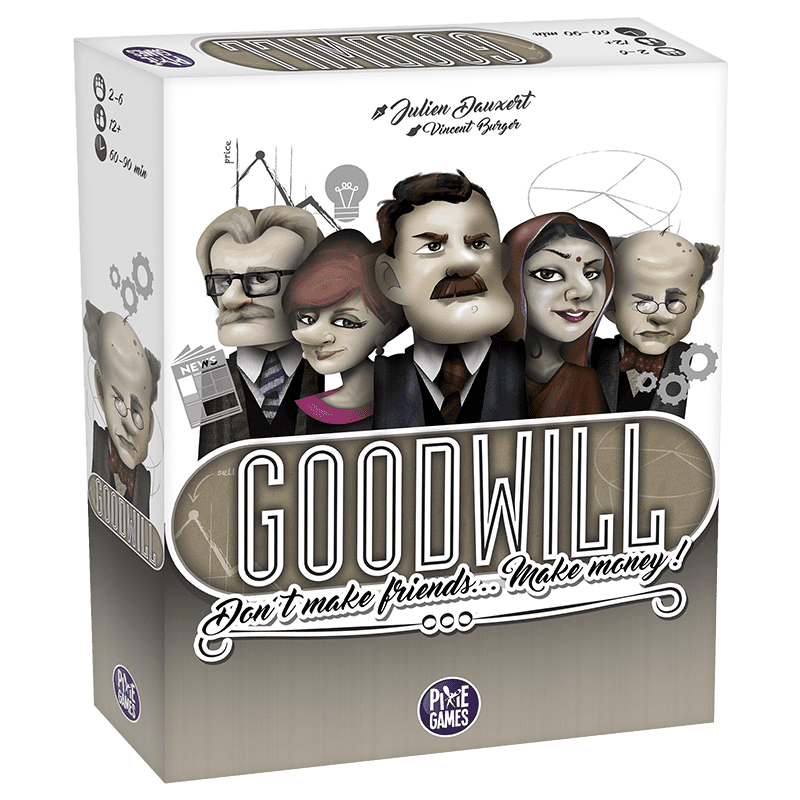If your board game group enjoys outsmarting each other and making deals that are shakier than my willpower around cheese puffs, you might want to check out my review of Goodwill. I played it with my friends, and after a heated session full of sneaky trades and plenty of laughs (and a bit of yelling), I figured it was time to spill the beans on what makes this game tick—and what doesn’t. So buckle up, because this isn’t your grandma’s bingo night. Let’s see if Goodwill deserves a spot on your game shelf—or if it should be left on the table at, well, Goodwill.
How It Plays
Setting up
First, put the main board in the middle of the table. Everyone gets a set of colored chips and a handful of starting cards. Place the “Goodwill” tokens nearby. Shuffle the deal cards and hand out your secret goals. I suggest grabbing snacks now, because people will stare at these cards like they’re deciphering an ancient prophecy.
Gameplay
Each round, players secretly make offers to others, either trading resources, brokering alliances, or—if you’re my friend Rob—making wild promises that he’ll 100% forget next turn. Players negotiate, exchange, and try to score big while keeping a wary eye on everyone else’s moves. After everyone’s offers are revealed, trades are resolved, points are tallied, and the board gets updated. This repeats for a set number of rounds. Chaos is encouraged. Betrayal is optional, but much funnier.
Winning the game
At the end, everyone counts up their points from completed deals, secret goals, and tokens. The player with the most points is crowned the Goodwill master. If you’re like me, you’ll probably be the Goodwill disaster, but hey, second place isn’t so bad!
Want to know more? Read our extensive strategy guide for Goodwill.
Easy Rules, Sneaky Tricks: How Goodwill Wins with Simple Mechanics
I cracked open “goodwill” with my regular game group – the ones who are always one snack spill away from disaster. Right out of the box, goodwill hits you with clear rules. The rulebook is thinner than my patience for Monopoly, and that’s saying a lot. We spent about five minutes arguing over whose turn it was to read, but the instructions were so simple even my friend Dave (who once got lost inside an IKEA) understood what to do.
The main mechanic in goodwill is all about trading influence. There are no dice to roll and no wild luck swings. Instead, you make choices. Every round, players secretly plan who to help and who to ignore. Points are scored by how much trust and ‘goodwill’ you manage to build. Actions feel clever. I love games where you rely on wits, and here you can’t blame anything on the luck of a card shuffle.
Rules stay out of your way. Whenever we got stuck, we found the answer in the rulebook in under a minute. It’s not full of weird corner cases or pages and pages of exceptions. The mechanics are so balanced that nobody felt cheated when they lost (not even me, and I am a sore loser). I only wish the scoring track was bigger. With more than four players, it gets a little cramped – not a dealbreaker, but you might knock over a few pieces in the heat of gameplay.
Next time, I’ll tell you if all that sneaky trust-building in goodwill helps friends work together…or ends with someone yelling “TRAITOR!” during player interaction and negotiation.
How Goodwill Brings Out the Deal-Makers: Player Interaction and Negotiation
Let me tell you, Goodwill is a game that turns even the quietest players at my table into sneaky negotiators. If you’ve ever wanted to see your mild-mannered aunt pull off a trade like she’s on Wall Street, this is your jam. The entire focus of the game is about making deals, trading, and bluffing your way to the best outcome. No matter how many times my friends and I play, someone always tries to form a secret pact. Spoiler: it never lasts. But that is half the fun!
Goodwill doesn’t just allow negotiation—it absolutely demands it. The mechanics force players to talk, persuade, and sometimes beg. This can make the game super energetic. Whether you’re offering a trade or sabotaging someone’s plan, you’ll constantly find yourself in the thick of the action. I watched my friend Doug, who never speaks above a whisper, suddenly take center stage in a heated three-way trade. Doug hasn’t stopped bragging since. So, if you have a group of players who like chatting and scheming, this one is a sure hit.
There are no complicated diplomacy rules or endless discussion phases. You negotiate, you shake on it (or don’t), and you move on. This keeps everyone involved and focused. But watch out: if you hate confrontation, or you’re allergic to haggling, Goodwill can get a bit intense! You can’t really play quietly in the corner—not unless you want to lose. The game rewards boldness and clever talking, and sometimes, a well-timed bluff is worth more than any resource.
As for what comes next, let me just say: replay value and game length in Goodwill is almost as unpredictable as Doug’s next negotiation scheme!
How Many Times Can You Pass Go? Replay Value and Game Length in Goodwill
If there’s one thing my board game crew loves, it’s a game that keeps us coming back for more. Goodwill snagged our interest quick, but does it stick around in our rotation, or is it like that one friend who only shows up for pizza? Let’s see.
Each time we played Goodwill, we found a new angle to try. The game’s replay value mostly comes from its changing player dynamics. Because deals shift and each group has its own wild way of bartering, every session feels different. One night, I nearly convinced everyone my stack of chips had magic powers. The next, Tom wouldn’t even swap a single coin unless I promised my next snack run. You just never know what will happen—except that people will argue like they’re on some low-budget reality TV show. Every. Single. Time.
Game length is good news too. Goodwill wraps up in about 30–45 minutes even with our crew’s occasional dramatic pauses for snack breaks and debating whose deal was the worst. The pacing feels just right: long enough for big moves, short enough that nobody gets bored. With three players, it’s snappy. With five, it’s a full-on trading market, and chaos rules the day. But it never drags. Even our most restless friend (the one who checks his phone between turns) paid attention the whole time. That’s impressive.
All in all, Goodwill is easy to replay and doesn’t overstay its welcome. If you want a game that keeps things fresh and lively, this one’s a safe bet. Next up, let’s see whether the game looks as sharp as it plays—and yes, I will judge the chips.
Component Quality and Artwork in Goodwill: Does It Spark Joy?
Alright, let’s talk about the physical stuff—the bits and bobs in Goodwill that you get to toss around and (let’s be honest) maybe lose under the couch. As soon as I cracked open the box, I got that fresh board game smell. You know what I mean. It’s the smell of promises and maybe a tiny bit of cardboard dust.
The cards in Goodwill feel sturdy, not like those cheap flyers you get stuck on your car windshield. You can shuffle them a bunch and they’re still not fraying. But here’s the kicker: the tokens are just OK. Don’t get me wrong—they’re not awful, but I wouldn’t call home about them either. During one game night, my cat swiped a token off the table, and it survived, but it doesn’t exactly feel like heirloom material. If you love chunky wooden pieces, you might be a little bummed. They’re more ‘serviceable’ than ‘show-off to your friends.’
Artwork-wise, Goodwill keeps it simple. The art is clean, easy to read, and never gets in the way of gameplay. Some of my friends call it ‘boring,’ but I sort of like that it won’t give me a headache after three rounds. It’s all about function over flash, which is fine when you’re focused on bluffing your way to victory.
So, would I recommend Goodwill based on components and artwork alone? Not if you want a table centerpeice, but I think it’s more about what happens on the board than what the board looks like. If you’re here for gameplay and don’t mind a bit of basic, I say go for it!
Conclusion
So, would I trade my last slice of pizza for another game of Goodwill? Almost! Goodwill nails what it sets out to do—create quick, quirky trading chaos with simple rules that even my friend Kevin (who once tried to trade his socks for a Monopoly hotel) understands. Sure, the art and pieces won’t win awards, but that makes it feel even more like a real flea market. Every round brings new deals and hilarious moments, and luck never gets in the way of skillful haggling. If you want a lively, negotiation-heavy game for game night, Goodwill is a solid bet. Just don’t expect fancy bits or stunning art, and be ready to argue over the last points marker. That’s it for this review—thanks for reading, and happy gaming!


